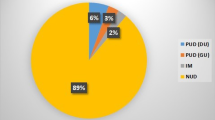Abstract
Objectives Helicobacter pylori (H. pylori) chronically infects the human stomach and may cause extra-gastrointestinal diseases. The role of H. pylori in the pathogenesis of atherosclerosis and its effect on lipids remains controversial. The aim of this study was to examine lipid levels in patients with and without H. pylori infection. Methods A total of 244 consecutive patients who underwent esophagogastroduodenoscopy were included in this study. Patients receiving statin and fibrate therapy and diabetic patients were excluded. Biopsies from each individual were taken and analyzed for H. pylori detection using ultrastructural methods. Patients were divided into two groups: H. pylori (+) (group 1) and H. pylori (−) (group 2). Total cholesterol (TC), low-density lipoprotein cholesterol (LDL-C), high-density lipoprotein cholesterol (HDL-C), and triglyceride levels were measured in all subjects. Results A total of 163 patients were included in group 1 and 81 patients were included in group 2. Frequency of H. pylori was 67% in the study population. Total cholesterol (204 ± 39 mg/dl versus 189 ± 42 mg/dl, respectively; P = 0.007) and LDL-C (128 ± 30 mg/dl versus 116 ± 32 mg/dl, respectively; P = 0.003) were significantly higher in group 1 than in group 2. Updated Sydney classification score showed a positive correlation with LDL-C (r = 0.333, P < 0.001) and TC (r = 0.288, P < 0.001) levels. Conclusion Increased levels of TC and LDL-C were found in patients infected with H. pylori, and updated Sydney System score showed a positive correlation with LDL-C and TC levels. These findings may explain why H. pylori infection is associated with increased risk of atherosclerosis.

Similar content being viewed by others
References
Blaser MJ (1992) Helicobacter pylori: its role in disease. Clin Infect Dis 15:386–393
Dixon MF, Genta RM, Yardley JH, Correa P (1996) Classification and grading of gastritis. The updated Sydney System. International workshop on the histopathology of gastritis, Houston 1994. Am J Surg Pathol 10:1161–1181
Danesh J, Collins R, Peto R (1997) Chronic infections and coronary heart disease: is there a link? Lancet 350:430–436. doi:10.1016/S0140-6736(97)03079-1
Scragg RK, Fraser A, Metcalf PA (1996) Helicobacter pylori seropositivity and cardiovascular risk factors in a multicultural workforce. J Epidemiol Community Health 50:578–579
Niemala S, Karttunen T, Korhonen T, Laara E, Karttunen R, Ikaheimo M, Kesaniemi YA (1996) Could Helicobacter pylori infection increase the risk of coronary heart disease by modifying serum lipid concentrations? Heart 75:573–575. doi:10.1136/hrt.75.6.573
Hoffmeister A, Rothenbacher D, Bode G et al (2001) Current infection with Helicobacter pylori, but not seropositivity to Chlamydia pneumoniae or Cytomegalovirus, is associated with an atherogenic, modified lipid profile. Arterioscler Thromb Vasc Biol 21:427–432
Zhu J, Quyyumi A, Muhlestein JB et al (2002) Lack of association of Helicobacter pylori infection with coronary artery disease and frequency of acute myocardial infarction or death. Am J Cardiol 89:155–158. doi:10.1016/S0002-9149(01)02192-0
Kinjo K, Sato H, Sato H et al (2002) Prevalence of H. pylori infection and its link to coronary risk factors in Japanese patients with acute myocardial infarction. Circ J 66:805–810. doi:10.1253/circj.66.805
Zhang L, Gail MH, Wang YQ, Brown LM, Pan KF, Ma JL, Amagase H, You WC, Moslehi R (2006) A randomized factorial study of the effects of long-term garlic and micronutrient supplementation and of 2-wk antibiotic treatment for Helicobacter pylori infection on serum cholesterol and lipoproteins. Am J Clin Nutr 84(4):912–919
Sung KC, Rhee EJ, Ryu SH, Beck SH (2005) Prevalence of Helicobacter pylori infection and its association with cardiovascular risk factors in Korean adults. Int J Cardiol 102(3):411–417. doi:10.1016/j.ijcard.2004.05.040
Kanbay M, Gür G, Yücel M, Yilmaz U, Boyacioğlu S (2005) Does eradication of Helicobacter pylori infection help normalize serum lipid and CRP levels? Dig Dis Sci 50(7):1228–1231. doi:10.1007/s10620-005-2764-9
Aslan M, Nazligul Y, Horoz M, Bolukbas C, Bolukbas FF, Gur M, Celik H, Erel O (2008) Serum paraoxonase-1 activity in Helicobacter pylori infected subjects. Atherosclerosis 196(1):270–274. doi:10.1016/j.atherosclerosis.2006.10.024
Gallin JL, Kaye D, O’Leary WM (1969) Serum lipid in infection. N Engl J Med 281:1081–1086
März W, Scharnagl H, Winkler K, Tiran A, Nauck M, Boehm BO, Winkelmann BR (2004) Low-density lipoprotein triglycerides associated with low-grade systemic inflammation, adhesion molecules, and angiographic coronary artery disease: the Ludwigshafen Risk and Cardiovascular Health study. Circulation 110(19):3068–3074. doi:10.1161/01.CIR.0000146898.06923.80
Author information
Authors and Affiliations
Corresponding author
Rights and permissions
About this article
Cite this article
Kucukazman, M., Yavuz, B., Sacikara, M. et al. The Relationship Between Updated Sydney System Score and LDL Cholesterol Levels in Patients Infected with Helicobacter pylori . Dig Dis Sci 54, 604–607 (2009). https://doi.org/10.1007/s10620-008-0391-y
Received:
Accepted:
Published:
Issue Date:
DOI: https://doi.org/10.1007/s10620-008-0391-y




